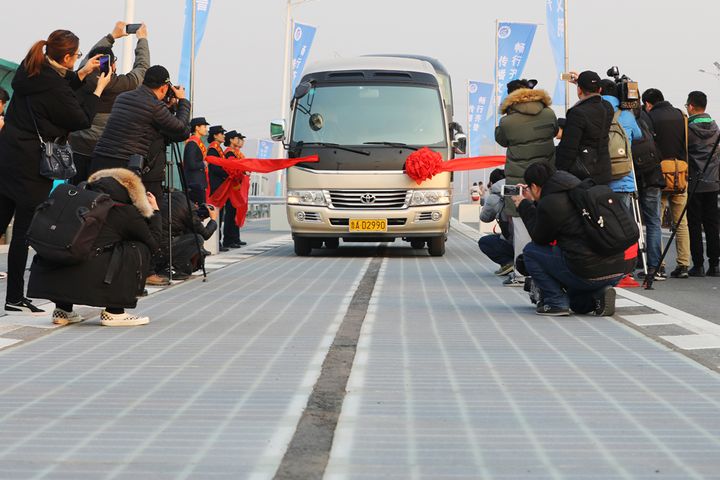 China Unveils Power-Generating Solar Highway
China Unveils Power-Generating Solar Highway(Yicai Global) Dec. 29 – East China's Shandong province has unveiled a solar highway, which utilizes solar energy. An expressway section installed with photovoltaic panels formally opened to traffic in Jinan, capital of East China's Shandong province yesterday. The highway utilizes solar energy for power generation to the grid.
The pilot section of the solar road is located at southern section of Jinan's city ring expressway, with a total length of 1,120 meters and photovoltaic pavement length of 1,080 meters, covering two lanes and one emergency lane, state-owned China News Service reported. The experimental section's power generation capacity peak power reached 817.2 kilowatts, with annual generating capacity of about 1 million kilowatt-hours.
At present, the test section has generated electricity and has been integrated into the state grid to power highway lights, signboards, deicing salt sprinkler facilities, tunnels and toll gate facilities, with excess power supplied to the grid, said Xu Chunfu, chairman of Qilu Transportation Development Group Co., the investor for the road.
The photovoltaic highway uses a three-layer structure including light-transmitting concrete, photovoltaic power generation components and insulation protection. The outer layer is high-strength transparent concrete road surface with light transmission over 90 percent. Photovoltaic panels are in the middle to absorb sunlight for generation of power. The bottom is insulation layer. The total thickness of the three-layer structure is less than three centimeters, explained Zhang Hongchao, head of photovoltaic pavement project for the solar highway and chief scientist of Shandong-based Pavenergy Co.
The transparent concrete can withstand a variety of vehicles. It has a rough surface with more friction than ordinary highways, without forming a specular reflection, endangering driving safety.
The design load of photovoltaic pavement adopts China's current national highway standard. "The indicators such as design life, mechanical parameters and road performance are higher than the existing normal asphalt roads," Zhang said.
Future functions to be developed include electronic traffic signs and markings, mobile charging for electric vehicles, snow melting, internet coverage and Big Data integration and analysis, Xu said.